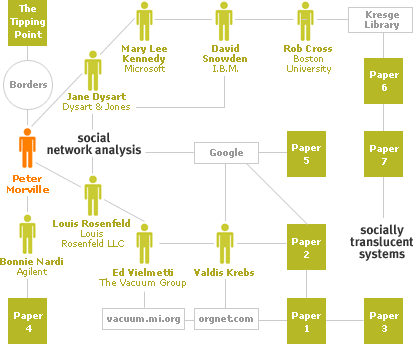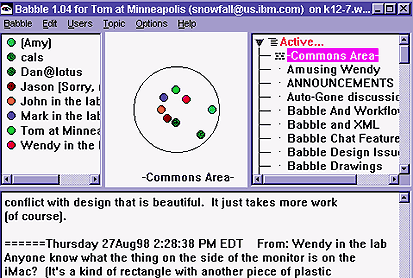How do knowledge workers learn? How do they decide what to learn next? What motivates them to share?
These questions are central to the challenges of knowledge management, and yet most corporate portals and online communities are designed in ignorance of their answers.
The truth lies within the social fabric that connects people to people and people to content. Relationships, trust and serendipity play key roles.
To illustrate, let me tell you a story about my recent foray into social network analysis, a strange world filled with mavens and connectors, structural holes, intensional networks, and socially translucent systems.
The Tipping Point
My interest in the ties between people and content isn’t new. In 1995, I helped design an information architecture strategy for Dow Chemical that placed the employee directory at the center of a rich web of relationships between authors and documents.
And two years ago, I invited Bonnie Nardi to speak at IA2K about her fascinating work on information ecologies and social networks.
But it was two events last month that prompted my current enthusiasm.
First, I discovered The Tipping Point while browsing Borders bookstore. The notion of Connectors (who know everyone) and Mavens (experts who love to teach) as catalysts of social epidemics really caught my attention.
Second, I had lunch with Lou Rosenfeld, who had just been talking with Ed Vielmetti, who is now working with Valdis Krebs to distribute software for “social network analysis.”

Interactive Story Map of My SNA Learning Process
This discussion sparked my interest and gave me names and keywords to feed into Google, producing some great articles.
While traveling, I mentioned SNA to Jane Dysart and Mary Lee Kennedy. Both pointed me to Dave Snowden who told me about Rob Cross.
In the period of a few weeks, I learned quite a bit about the people and ideas surrounding social network analysis.
The ABCs of Network Analysis
Valdis Krebs states “organization charts prescribe that work and information flow in a hierarchy, but network mapping reveals [they] actually flow through a vast web of informal channels.”
Social network analysis involves the mapping and measuring of these normally invisible relationships between people, providing an organizational X-ray for use by HR managers and consultants.

Kite Network ideas developed by David Krackhardt and Valdis Krebs
SNA tools such as InFlow help reveal densely connected clusters or communities of practice, and support the three most popular metrics:
- Activity. Susan is a “connector” with 6 direct links to other nodes.
- Betweenness. Claudia has only 3 connections but holds a powerful position as the sole “boundary spanner” between different groups.
- Closeness. Sarah and Steven have the shortest paths to all others. They have an excellent view of what’s going on.
These tools and metrics can be applied at the level of individuals, organizations and industries. They can also be used to analyze computer networks (to optimize topology) and information systems (imagine a visual representation of Google’s link analysis).
Human Surrogates
What ties information architecture, knowledge management and social network analysis more closely together is the reciprocal relationship between people and content.

Success in the former requires we know what other people know and who other people know. Success in the latter demands good search, navigation and content management systems.
In information retrieval, we often use document surrogates such as abstracts to represent the knowledge contained within that content.
We might also think of the documents themselves as “human surrogates,” representing the knowledge and interests of authors.
And of course, we humans also serve as surrogates for one another.
In the context of enterprise KM, this suggests a need for metadata schema, tools, staff directories and incentives to enable and encourage explicit connections between documents and authors.
Socially Translucent Systems
My SNA research eventually led me to socially translucent systems and an instant messenger on steroids named Babble.
Built upon the rationale that “visibility yields awareness yields accountability,” Babble makes people aware of one another’s presence and activity in both real-time and asynchronous modes.

Screenshot of IBM’s Babble
Notice the “marbles” in the Commons Area? These “social proxies” indicate the relative activity levels of users, whether they’re speaking or just listening to the conversation. Yes, even lurkers are exposed to the light of day.
Babble motivates by enabling people to build social capital and manages contribution quality through peer pressure and social feedback. Put simply, nobody wants to lose their marbles.
Beyond Babble
The concepts of network analysis and socially translucent systems are applicable far beyond the confines of text-based chat.
In fact, these concepts are critical to the creation of truly useful knowledge economies and online communities.
The seeds of innovation are lying all around us, from Google’s Backward Links to AOL’s Buddy Lists to Amazon’s Purchase Circles to the incestuous source links of Blogdex.
We humans are very social animals. It’s about time more of us started recognizing this in the systems we design.
by Peter Morville